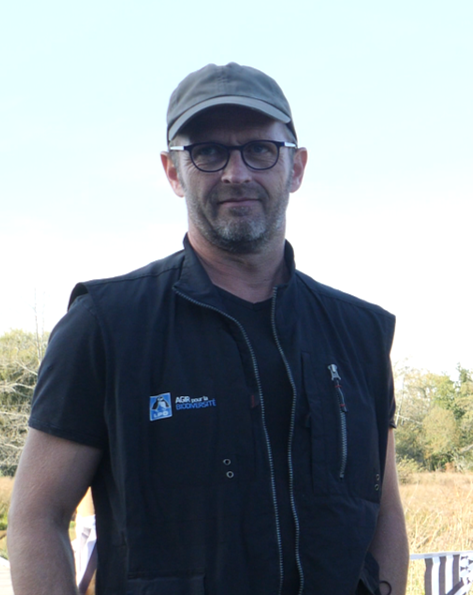On 9 October 2021, the Biodiversity Observatory opened in La Gacilly. We met with Sébastien Gervaise, the nature studies manager at LPO (French organisation for the protection of birds) who provided his considerable expertise to help launch this new project.
What is the LPO ?
Sébastien : Founded in Brittany in 1912, the LPO has become an important non-profit organisation in France and beyond. LPO stands for “Ligue pour la Protection des Oiseaux”, the French society for the protection of birds, but we’ve extended our focus beyond birds alone for some time now. In fact, we care for the whole natural world, which is why we say, “LPO takes action for biodiversity”.
The LPO’s key actions are:
- Preserving natural environments such as by managing nature reserves;
- Conducting research, doing lots of monitoring and inventories, and observing animals and how environments change;
- Awareness-raising: lots of activity leaders work full time with schoolchildren and the public to raise awareness of how we can protect and explore biodiversity and the natural world around us; and
- Managing rehabilitation centres: all the birds we find injured or covered in oil go to rehabilitation centres so that they can be cared for and released.
What is your role at the LPO?
S :
At first, I was involved in environmental education. I led activities in schools and organised learning programmes for the public. Little by little, we started doing monitoring, research and environmental inventories. Now, I do more than that. I’m in charge of nature studies.
50% of bird species have gone extinct. What is the picture like in Brittany? What impact have you noticed at the Observatory?
S : Over the past few decades, agricultural issues have had a very negative impact on farmland birds’ habitats, such as hedgerows and natural grasslands. Both intensified farming and the reversal of policies around mandatory fallow periods more than 10 years ago have meant that natural grasslands have disappeared, all of which has a very negative impact on farmland birds’ habitats.
Another important factor is the destruction of wetlands because, in addition to providing a habitat for birds, they are somewhere for migratory birds to pass through. If we destroy wetlands, migratory birds can’t carry on their travels because they can’t find food or rest.
Naturally, we’ve observed this in Brittany too as it’s a very agricultural region with 70% of its land dedicated to farming. That’s why we are trying to work more and more with local farmers as this is what will help us move the dial.
We did things a bit differently at the Biodiversity Observatory. We came up with the idea of transforming the existing poplar plantations into a wetland which would offer more interesting biodiversity. The objective was to recreate a real wetland environment. The results are already there to see as a few species are already starting to come back, including water violets. Heritage insect and bird species (which are specially adapted and unique to wetlands) are also coming back, particularly the large marsh grasshoppers and short-winged coneheads, both of which are essential wetland species.
What do you think about biodiversity loss?
S : What needs to change is how we all think about nature. We need people to understand that biodiversity is on our doorstep and that we don’t have to travel hundreds or thousands of miles to see nature.
We want to encourage people to get into the habit of observing nature again and change their perspective on their local environment because that’s also very varied and a home to biodiversity – biodiversity which has every right to exist and is just as interesting as we might find in other countries and faraway lands. We often see in our work that people are spending more and more time observing reptiles.
In your view, how can we encourage the public to protect biodiversity?
S : We are creating ways for people to get involved. Instead of making developments ourselves or having a business do them, we create them with volunteers who might work for or with that business. We did this with the Biodiversity Observatory. Over the course of a day or half-day, we did practical projects such as the spiral-shaped bug hotel and hibernaculum with employees from Yves Rocher, which is the sponsor behind the Yves Rocher Foundation.
Have you noticed a change in how the wider public, and young people in particular, have gotten involved in your workshops?
S : More and more people are getting interested in the issues we raise at our public workshops. In terms of students, one of our priorities is to train up-and-coming generations to observe, explore and protect nature.
In the Ille-et-Vilaine area, we have two activity leaders who work in secondary schools as part of a programme running projects over three, four or five sessions in which the young people are really making the decisions.
What has been your best nature experience?
S : Every other year, we organise a nature walk called “Owl Night” as part of a national campaign to help the general public encounter nocturnal birds of prey.
In 2001, it was a beautiful moonlit night where we were, and the groups had been able to observe nocturnal birds of prey – then I spotted the planets Saturn and Jupiter.
So, this already fantastic night finished off with a star-gazing session. It’s such a lovely memory. One of the things I like about this job is improvising. We have to make do with whatever nature offers us and lets us see, so sometimes you end up surprised. A simple bird-watching monocular is also good for seeing the rings of Saturn or Jupiter’s four satellites.
For more informations on our actions in La Gacilly and on the wetlands : discover Observatoire de la biodiversité.



